Critical Review of Public Relations Articles
VerifiedAdded on 2021/04/24
|17
|4378
|17
AI Summary
The assignment involves a critical review of public relations articles, focusing on the effectiveness of media in communicating health messages and contraceptive use in Kenya. The review uses various theories such as the Hypodermic Needle Theory and Cultivation Theory to understand how media influences people's decisions regarding contraceptive use. The research highlights that while print media had low success rates, radio and television were more effective in reaching the general public, particularly those living in slums. The assignment concludes by recommending further studies using modern theories and emphasizes the importance of effective communication in resolving crises or building relationships between politicians and citizens.
Contribute Materials
Your contribution can guide someone’s learning journey. Share your
documents today.
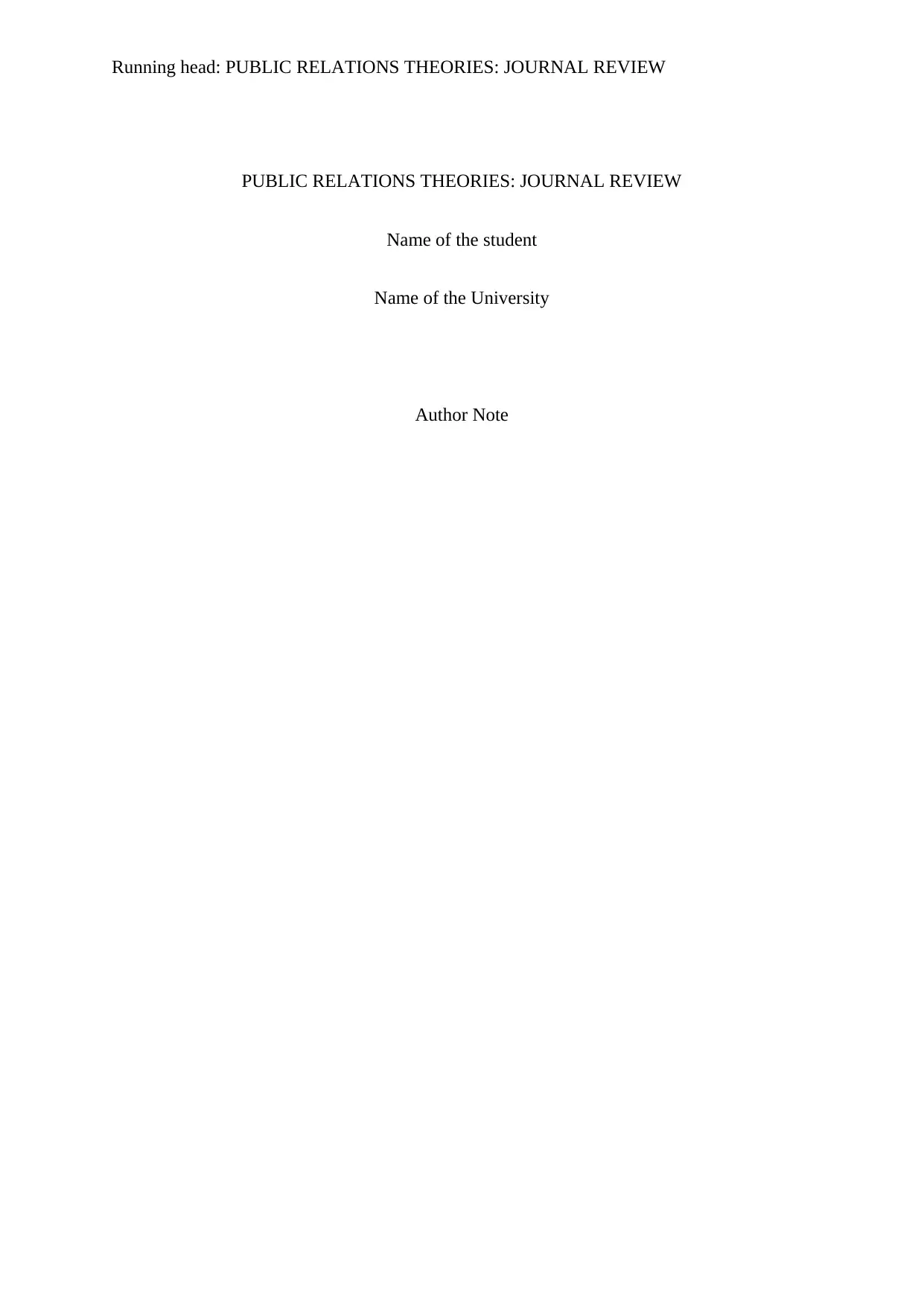
Running head: PUBLIC RELATIONS THEORIES: JOURNAL REVIEW
PUBLIC RELATIONS THEORIES: JOURNAL REVIEW
Name of the student
Name of the University
Author Note
PUBLIC RELATIONS THEORIES: JOURNAL REVIEW
Name of the student
Name of the University
Author Note
Secure Best Marks with AI Grader
Need help grading? Try our AI Grader for instant feedback on your assignments.
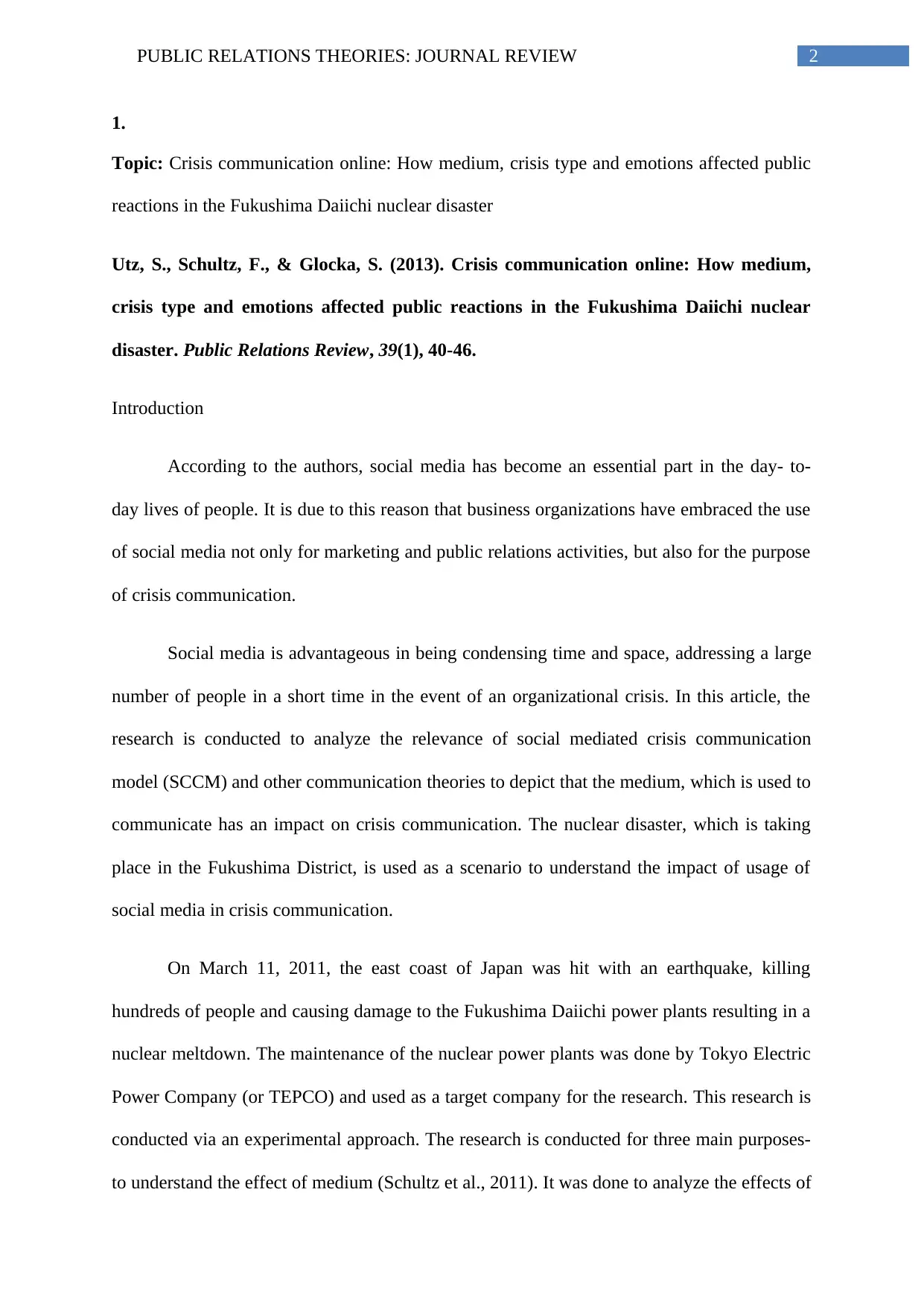
2PUBLIC RELATIONS THEORIES: JOURNAL REVIEW
1.
Topic: Crisis communication online: How medium, crisis type and emotions affected public
reactions in the Fukushima Daiichi nuclear disaster
Utz, S., Schultz, F., & Glocka, S. (2013). Crisis communication online: How medium,
crisis type and emotions affected public reactions in the Fukushima Daiichi nuclear
disaster. Public Relations Review, 39(1), 40-46.
Introduction
According to the authors, social media has become an essential part in the day- to-
day lives of people. It is due to this reason that business organizations have embraced the use
of social media not only for marketing and public relations activities, but also for the purpose
of crisis communication.
Social media is advantageous in being condensing time and space, addressing a large
number of people in a short time in the event of an organizational crisis. In this article, the
research is conducted to analyze the relevance of social mediated crisis communication
model (SCCM) and other communication theories to depict that the medium, which is used to
communicate has an impact on crisis communication. The nuclear disaster, which is taking
place in the Fukushima District, is used as a scenario to understand the impact of usage of
social media in crisis communication.
On March 11, 2011, the east coast of Japan was hit with an earthquake, killing
hundreds of people and causing damage to the Fukushima Daiichi power plants resulting in a
nuclear meltdown. The maintenance of the nuclear power plants was done by Tokyo Electric
Power Company (or TEPCO) and used as a target company for the research. This research is
conducted via an experimental approach. The research is conducted for three main purposes-
to understand the effect of medium (Schultz et al., 2011). It was done to analyze the effects of
1.
Topic: Crisis communication online: How medium, crisis type and emotions affected public
reactions in the Fukushima Daiichi nuclear disaster
Utz, S., Schultz, F., & Glocka, S. (2013). Crisis communication online: How medium,
crisis type and emotions affected public reactions in the Fukushima Daiichi nuclear
disaster. Public Relations Review, 39(1), 40-46.
Introduction
According to the authors, social media has become an essential part in the day- to-
day lives of people. It is due to this reason that business organizations have embraced the use
of social media not only for marketing and public relations activities, but also for the purpose
of crisis communication.
Social media is advantageous in being condensing time and space, addressing a large
number of people in a short time in the event of an organizational crisis. In this article, the
research is conducted to analyze the relevance of social mediated crisis communication
model (SCCM) and other communication theories to depict that the medium, which is used to
communicate has an impact on crisis communication. The nuclear disaster, which is taking
place in the Fukushima District, is used as a scenario to understand the impact of usage of
social media in crisis communication.
On March 11, 2011, the east coast of Japan was hit with an earthquake, killing
hundreds of people and causing damage to the Fukushima Daiichi power plants resulting in a
nuclear meltdown. The maintenance of the nuclear power plants was done by Tokyo Electric
Power Company (or TEPCO) and used as a target company for the research. This research is
conducted via an experimental approach. The research is conducted for three main purposes-
to understand the effect of medium (Schultz et al., 2011). It was done to analyze the effects of
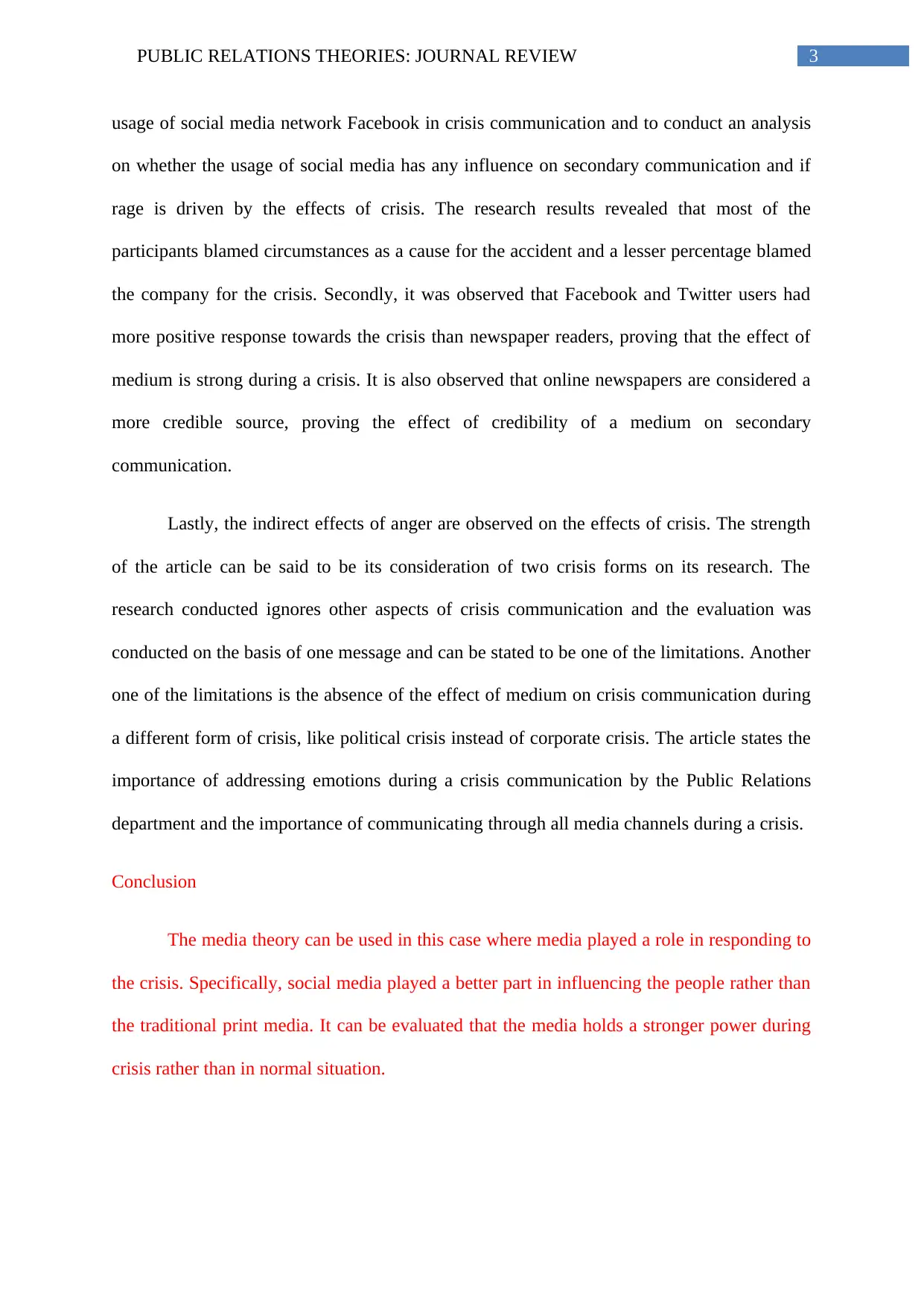
3PUBLIC RELATIONS THEORIES: JOURNAL REVIEW
usage of social media network Facebook in crisis communication and to conduct an analysis
on whether the usage of social media has any influence on secondary communication and if
rage is driven by the effects of crisis. The research results revealed that most of the
participants blamed circumstances as a cause for the accident and a lesser percentage blamed
the company for the crisis. Secondly, it was observed that Facebook and Twitter users had
more positive response towards the crisis than newspaper readers, proving that the effect of
medium is strong during a crisis. It is also observed that online newspapers are considered a
more credible source, proving the effect of credibility of a medium on secondary
communication.
Lastly, the indirect effects of anger are observed on the effects of crisis. The strength
of the article can be said to be its consideration of two crisis forms on its research. The
research conducted ignores other aspects of crisis communication and the evaluation was
conducted on the basis of one message and can be stated to be one of the limitations. Another
one of the limitations is the absence of the effect of medium on crisis communication during
a different form of crisis, like political crisis instead of corporate crisis. The article states the
importance of addressing emotions during a crisis communication by the Public Relations
department and the importance of communicating through all media channels during a crisis.
Conclusion
The media theory can be used in this case where media played a role in responding to
the crisis. Specifically, social media played a better part in influencing the people rather than
the traditional print media. It can be evaluated that the media holds a stronger power during
crisis rather than in normal situation.
usage of social media network Facebook in crisis communication and to conduct an analysis
on whether the usage of social media has any influence on secondary communication and if
rage is driven by the effects of crisis. The research results revealed that most of the
participants blamed circumstances as a cause for the accident and a lesser percentage blamed
the company for the crisis. Secondly, it was observed that Facebook and Twitter users had
more positive response towards the crisis than newspaper readers, proving that the effect of
medium is strong during a crisis. It is also observed that online newspapers are considered a
more credible source, proving the effect of credibility of a medium on secondary
communication.
Lastly, the indirect effects of anger are observed on the effects of crisis. The strength
of the article can be said to be its consideration of two crisis forms on its research. The
research conducted ignores other aspects of crisis communication and the evaluation was
conducted on the basis of one message and can be stated to be one of the limitations. Another
one of the limitations is the absence of the effect of medium on crisis communication during
a different form of crisis, like political crisis instead of corporate crisis. The article states the
importance of addressing emotions during a crisis communication by the Public Relations
department and the importance of communicating through all media channels during a crisis.
Conclusion
The media theory can be used in this case where media played a role in responding to
the crisis. Specifically, social media played a better part in influencing the people rather than
the traditional print media. It can be evaluated that the media holds a stronger power during
crisis rather than in normal situation.
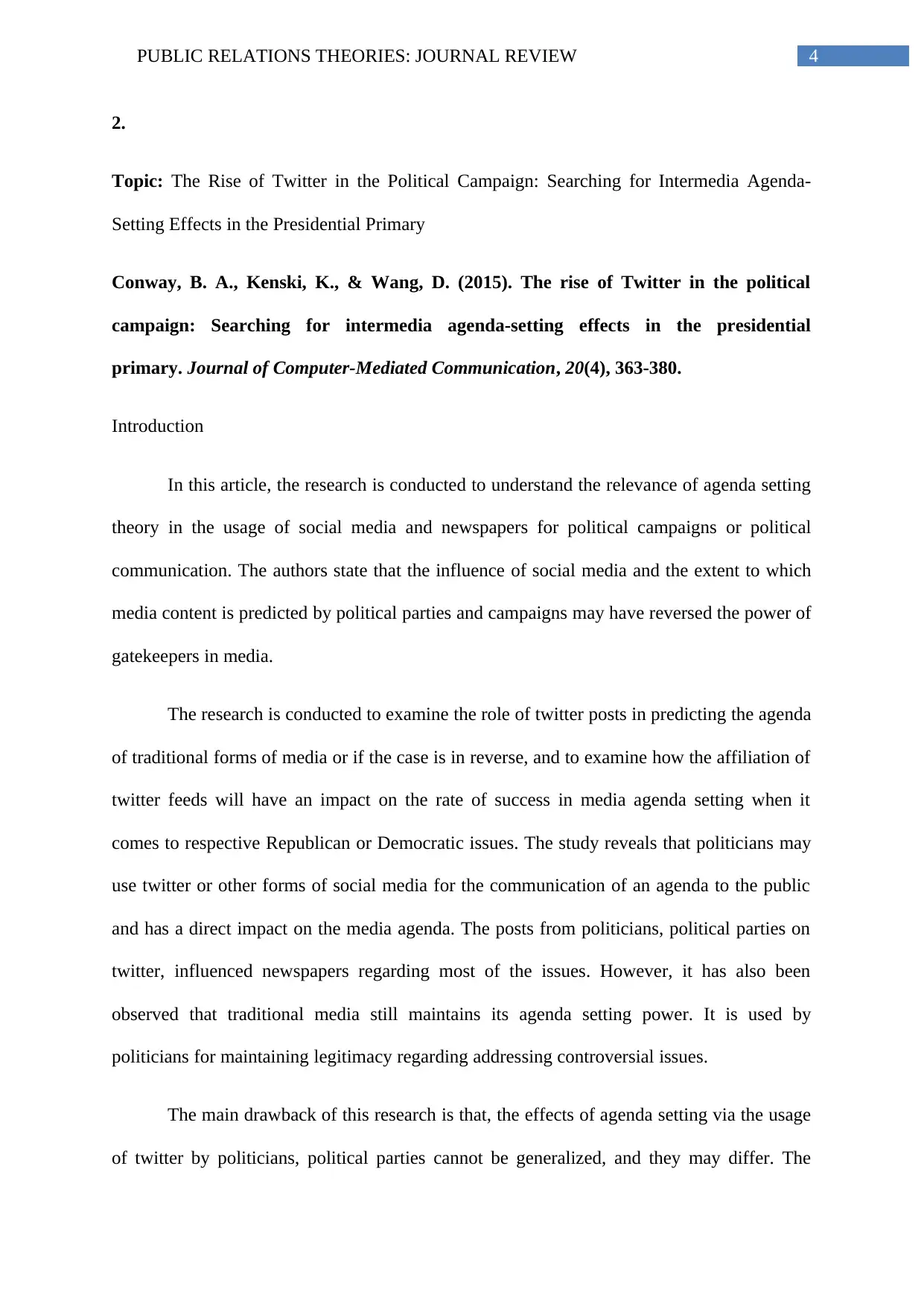
4PUBLIC RELATIONS THEORIES: JOURNAL REVIEW
2.
Topic: The Rise of Twitter in the Political Campaign: Searching for Intermedia Agenda-
Setting Effects in the Presidential Primary
Conway, B. A., Kenski, K., & Wang, D. (2015). The rise of Twitter in the political
campaign: Searching for intermedia agenda-setting effects in the presidential
primary. Journal of Computer-Mediated Communication, 20(4), 363-380.
Introduction
In this article, the research is conducted to understand the relevance of agenda setting
theory in the usage of social media and newspapers for political campaigns or political
communication. The authors state that the influence of social media and the extent to which
media content is predicted by political parties and campaigns may have reversed the power of
gatekeepers in media.
The research is conducted to examine the role of twitter posts in predicting the agenda
of traditional forms of media or if the case is in reverse, and to examine how the affiliation of
twitter feeds will have an impact on the rate of success in media agenda setting when it
comes to respective Republican or Democratic issues. The study reveals that politicians may
use twitter or other forms of social media for the communication of an agenda to the public
and has a direct impact on the media agenda. The posts from politicians, political parties on
twitter, influenced newspapers regarding most of the issues. However, it has also been
observed that traditional media still maintains its agenda setting power. It is used by
politicians for maintaining legitimacy regarding addressing controversial issues.
The main drawback of this research is that, the effects of agenda setting via the usage
of twitter by politicians, political parties cannot be generalized, and they may differ. The
2.
Topic: The Rise of Twitter in the Political Campaign: Searching for Intermedia Agenda-
Setting Effects in the Presidential Primary
Conway, B. A., Kenski, K., & Wang, D. (2015). The rise of Twitter in the political
campaign: Searching for intermedia agenda-setting effects in the presidential
primary. Journal of Computer-Mediated Communication, 20(4), 363-380.
Introduction
In this article, the research is conducted to understand the relevance of agenda setting
theory in the usage of social media and newspapers for political campaigns or political
communication. The authors state that the influence of social media and the extent to which
media content is predicted by political parties and campaigns may have reversed the power of
gatekeepers in media.
The research is conducted to examine the role of twitter posts in predicting the agenda
of traditional forms of media or if the case is in reverse, and to examine how the affiliation of
twitter feeds will have an impact on the rate of success in media agenda setting when it
comes to respective Republican or Democratic issues. The study reveals that politicians may
use twitter or other forms of social media for the communication of an agenda to the public
and has a direct impact on the media agenda. The posts from politicians, political parties on
twitter, influenced newspapers regarding most of the issues. However, it has also been
observed that traditional media still maintains its agenda setting power. It is used by
politicians for maintaining legitimacy regarding addressing controversial issues.
The main drawback of this research is that, the effects of agenda setting via the usage
of twitter by politicians, political parties cannot be generalized, and they may differ. The
Secure Best Marks with AI Grader
Need help grading? Try our AI Grader for instant feedback on your assignments.
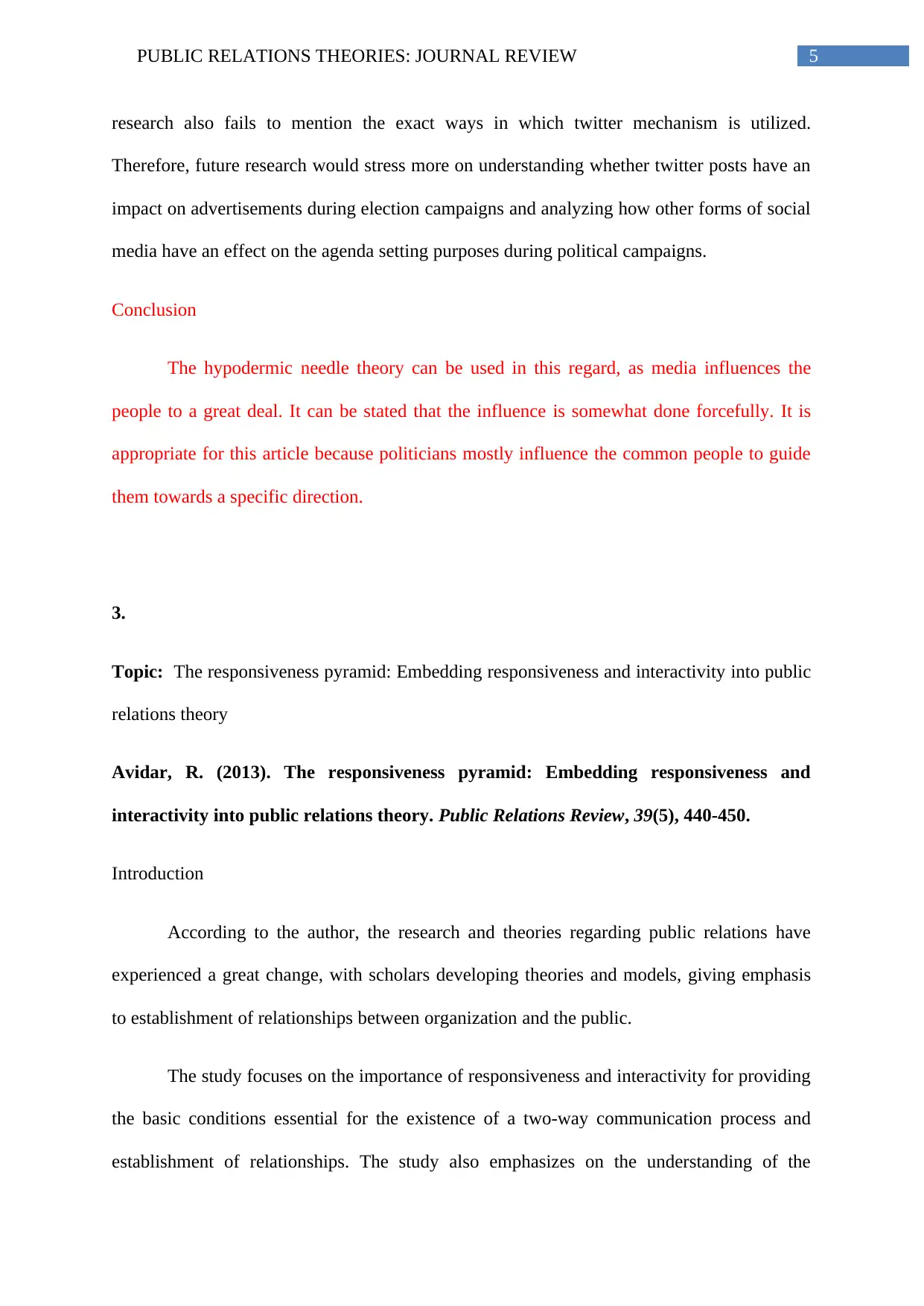
5PUBLIC RELATIONS THEORIES: JOURNAL REVIEW
research also fails to mention the exact ways in which twitter mechanism is utilized.
Therefore, future research would stress more on understanding whether twitter posts have an
impact on advertisements during election campaigns and analyzing how other forms of social
media have an effect on the agenda setting purposes during political campaigns.
Conclusion
The hypodermic needle theory can be used in this regard, as media influences the
people to a great deal. It can be stated that the influence is somewhat done forcefully. It is
appropriate for this article because politicians mostly influence the common people to guide
them towards a specific direction.
3.
Topic: The responsiveness pyramid: Embedding responsiveness and interactivity into public
relations theory
Avidar, R. (2013). The responsiveness pyramid: Embedding responsiveness and
interactivity into public relations theory. Public Relations Review, 39(5), 440-450.
Introduction
According to the author, the research and theories regarding public relations have
experienced a great change, with scholars developing theories and models, giving emphasis
to establishment of relationships between organization and the public.
The study focuses on the importance of responsiveness and interactivity for providing
the basic conditions essential for the existence of a two-way communication process and
establishment of relationships. The study also emphasizes on the understanding of the
research also fails to mention the exact ways in which twitter mechanism is utilized.
Therefore, future research would stress more on understanding whether twitter posts have an
impact on advertisements during election campaigns and analyzing how other forms of social
media have an effect on the agenda setting purposes during political campaigns.
Conclusion
The hypodermic needle theory can be used in this regard, as media influences the
people to a great deal. It can be stated that the influence is somewhat done forcefully. It is
appropriate for this article because politicians mostly influence the common people to guide
them towards a specific direction.
3.
Topic: The responsiveness pyramid: Embedding responsiveness and interactivity into public
relations theory
Avidar, R. (2013). The responsiveness pyramid: Embedding responsiveness and
interactivity into public relations theory. Public Relations Review, 39(5), 440-450.
Introduction
According to the author, the research and theories regarding public relations have
experienced a great change, with scholars developing theories and models, giving emphasis
to establishment of relationships between organization and the public.
The study focuses on the importance of responsiveness and interactivity for providing
the basic conditions essential for the existence of a two-way communication process and
establishment of relationships. The study also emphasizes on the understanding of the
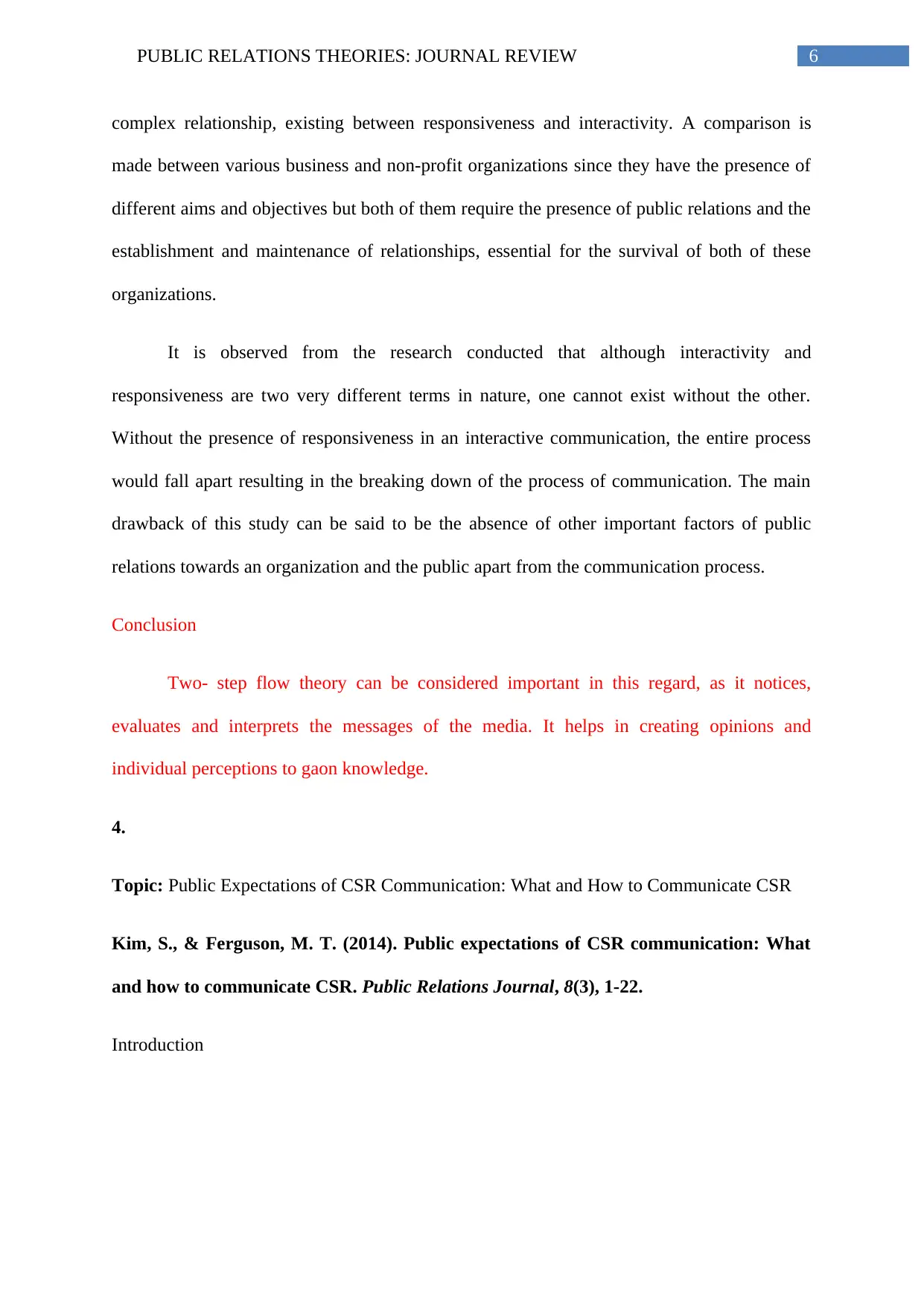
6PUBLIC RELATIONS THEORIES: JOURNAL REVIEW
complex relationship, existing between responsiveness and interactivity. A comparison is
made between various business and non-profit organizations since they have the presence of
different aims and objectives but both of them require the presence of public relations and the
establishment and maintenance of relationships, essential for the survival of both of these
organizations.
It is observed from the research conducted that although interactivity and
responsiveness are two very different terms in nature, one cannot exist without the other.
Without the presence of responsiveness in an interactive communication, the entire process
would fall apart resulting in the breaking down of the process of communication. The main
drawback of this study can be said to be the absence of other important factors of public
relations towards an organization and the public apart from the communication process.
Conclusion
Two- step flow theory can be considered important in this regard, as it notices,
evaluates and interprets the messages of the media. It helps in creating opinions and
individual perceptions to gaon knowledge.
4.
Topic: Public Expectations of CSR Communication: What and How to Communicate CSR
Kim, S., & Ferguson, M. T. (2014). Public expectations of CSR communication: What
and how to communicate CSR. Public Relations Journal, 8(3), 1-22.
Introduction
complex relationship, existing between responsiveness and interactivity. A comparison is
made between various business and non-profit organizations since they have the presence of
different aims and objectives but both of them require the presence of public relations and the
establishment and maintenance of relationships, essential for the survival of both of these
organizations.
It is observed from the research conducted that although interactivity and
responsiveness are two very different terms in nature, one cannot exist without the other.
Without the presence of responsiveness in an interactive communication, the entire process
would fall apart resulting in the breaking down of the process of communication. The main
drawback of this study can be said to be the absence of other important factors of public
relations towards an organization and the public apart from the communication process.
Conclusion
Two- step flow theory can be considered important in this regard, as it notices,
evaluates and interprets the messages of the media. It helps in creating opinions and
individual perceptions to gaon knowledge.
4.
Topic: Public Expectations of CSR Communication: What and How to Communicate CSR
Kim, S., & Ferguson, M. T. (2014). Public expectations of CSR communication: What
and how to communicate CSR. Public Relations Journal, 8(3), 1-22.
Introduction
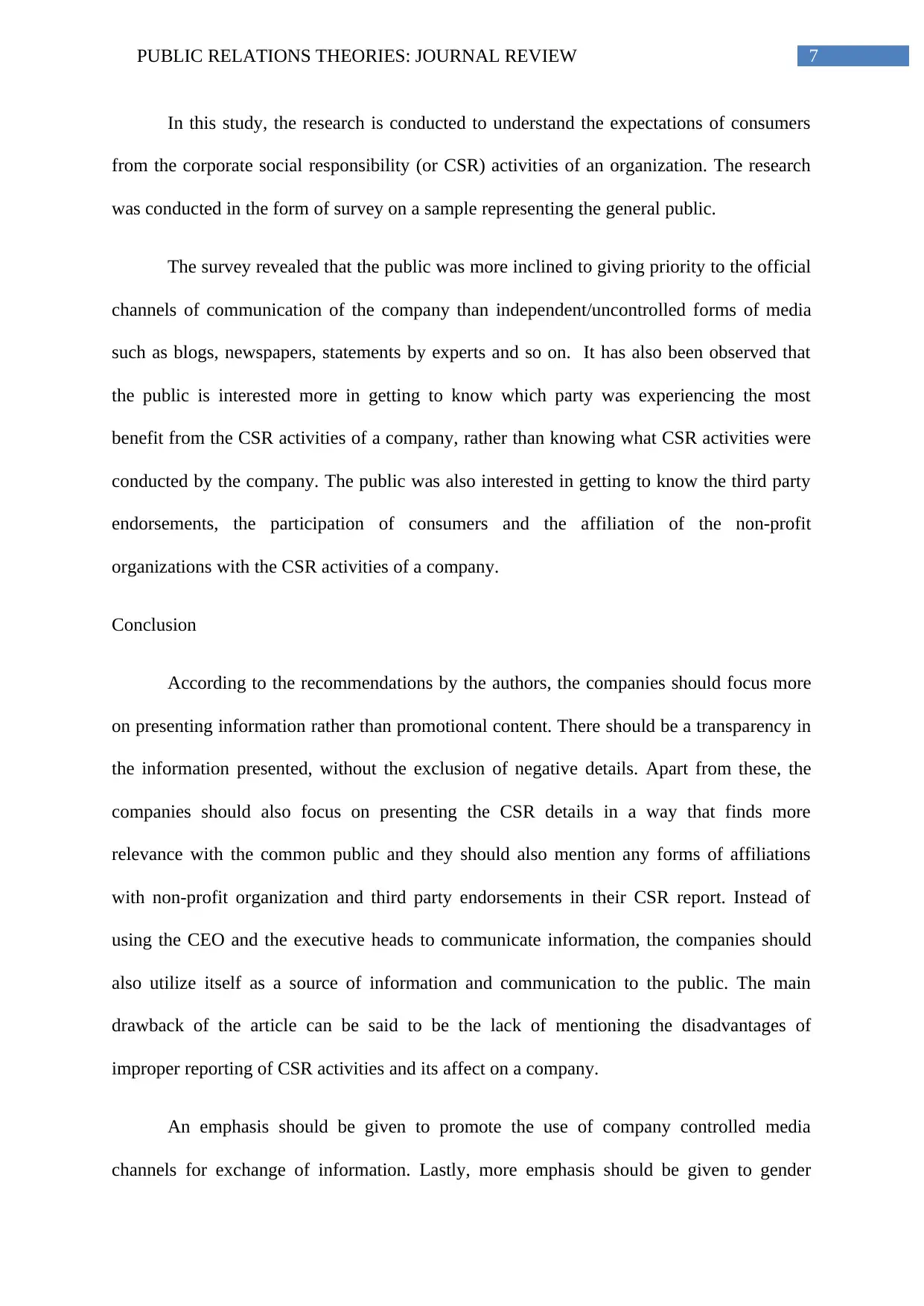
7PUBLIC RELATIONS THEORIES: JOURNAL REVIEW
In this study, the research is conducted to understand the expectations of consumers
from the corporate social responsibility (or CSR) activities of an organization. The research
was conducted in the form of survey on a sample representing the general public.
The survey revealed that the public was more inclined to giving priority to the official
channels of communication of the company than independent/uncontrolled forms of media
such as blogs, newspapers, statements by experts and so on. It has also been observed that
the public is interested more in getting to know which party was experiencing the most
benefit from the CSR activities of a company, rather than knowing what CSR activities were
conducted by the company. The public was also interested in getting to know the third party
endorsements, the participation of consumers and the affiliation of the non-profit
organizations with the CSR activities of a company.
Conclusion
According to the recommendations by the authors, the companies should focus more
on presenting information rather than promotional content. There should be a transparency in
the information presented, without the exclusion of negative details. Apart from these, the
companies should also focus on presenting the CSR details in a way that finds more
relevance with the common public and they should also mention any forms of affiliations
with non-profit organization and third party endorsements in their CSR report. Instead of
using the CEO and the executive heads to communicate information, the companies should
also utilize itself as a source of information and communication to the public. The main
drawback of the article can be said to be the lack of mentioning the disadvantages of
improper reporting of CSR activities and its affect on a company.
An emphasis should be given to promote the use of company controlled media
channels for exchange of information. Lastly, more emphasis should be given to gender
In this study, the research is conducted to understand the expectations of consumers
from the corporate social responsibility (or CSR) activities of an organization. The research
was conducted in the form of survey on a sample representing the general public.
The survey revealed that the public was more inclined to giving priority to the official
channels of communication of the company than independent/uncontrolled forms of media
such as blogs, newspapers, statements by experts and so on. It has also been observed that
the public is interested more in getting to know which party was experiencing the most
benefit from the CSR activities of a company, rather than knowing what CSR activities were
conducted by the company. The public was also interested in getting to know the third party
endorsements, the participation of consumers and the affiliation of the non-profit
organizations with the CSR activities of a company.
Conclusion
According to the recommendations by the authors, the companies should focus more
on presenting information rather than promotional content. There should be a transparency in
the information presented, without the exclusion of negative details. Apart from these, the
companies should also focus on presenting the CSR details in a way that finds more
relevance with the common public and they should also mention any forms of affiliations
with non-profit organization and third party endorsements in their CSR report. Instead of
using the CEO and the executive heads to communicate information, the companies should
also utilize itself as a source of information and communication to the public. The main
drawback of the article can be said to be the lack of mentioning the disadvantages of
improper reporting of CSR activities and its affect on a company.
An emphasis should be given to promote the use of company controlled media
channels for exchange of information. Lastly, more emphasis should be given to gender
Paraphrase This Document
Need a fresh take? Get an instant paraphrase of this document with our AI Paraphraser
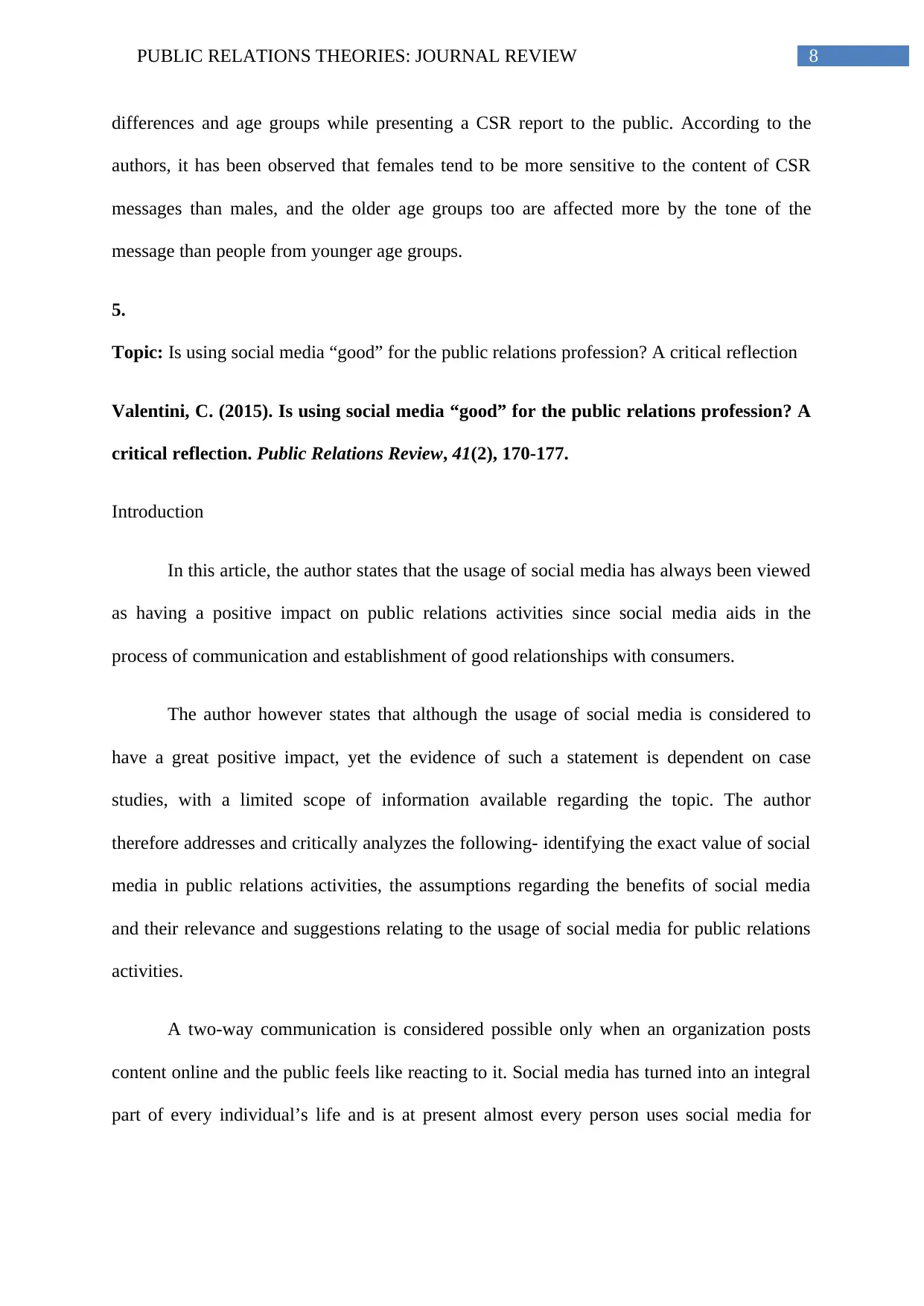
8PUBLIC RELATIONS THEORIES: JOURNAL REVIEW
differences and age groups while presenting a CSR report to the public. According to the
authors, it has been observed that females tend to be more sensitive to the content of CSR
messages than males, and the older age groups too are affected more by the tone of the
message than people from younger age groups.
5.
Topic: Is using social media “good” for the public relations profession? A critical reflection
Valentini, C. (2015). Is using social media “good” for the public relations profession? A
critical reflection. Public Relations Review, 41(2), 170-177.
Introduction
In this article, the author states that the usage of social media has always been viewed
as having a positive impact on public relations activities since social media aids in the
process of communication and establishment of good relationships with consumers.
The author however states that although the usage of social media is considered to
have a great positive impact, yet the evidence of such a statement is dependent on case
studies, with a limited scope of information available regarding the topic. The author
therefore addresses and critically analyzes the following- identifying the exact value of social
media in public relations activities, the assumptions regarding the benefits of social media
and their relevance and suggestions relating to the usage of social media for public relations
activities.
A two-way communication is considered possible only when an organization posts
content online and the public feels like reacting to it. Social media has turned into an integral
part of every individual’s life and is at present almost every person uses social media for
differences and age groups while presenting a CSR report to the public. According to the
authors, it has been observed that females tend to be more sensitive to the content of CSR
messages than males, and the older age groups too are affected more by the tone of the
message than people from younger age groups.
5.
Topic: Is using social media “good” for the public relations profession? A critical reflection
Valentini, C. (2015). Is using social media “good” for the public relations profession? A
critical reflection. Public Relations Review, 41(2), 170-177.
Introduction
In this article, the author states that the usage of social media has always been viewed
as having a positive impact on public relations activities since social media aids in the
process of communication and establishment of good relationships with consumers.
The author however states that although the usage of social media is considered to
have a great positive impact, yet the evidence of such a statement is dependent on case
studies, with a limited scope of information available regarding the topic. The author
therefore addresses and critically analyzes the following- identifying the exact value of social
media in public relations activities, the assumptions regarding the benefits of social media
and their relevance and suggestions relating to the usage of social media for public relations
activities.
A two-way communication is considered possible only when an organization posts
content online and the public feels like reacting to it. Social media has turned into an integral
part of every individual’s life and is at present almost every person uses social media for
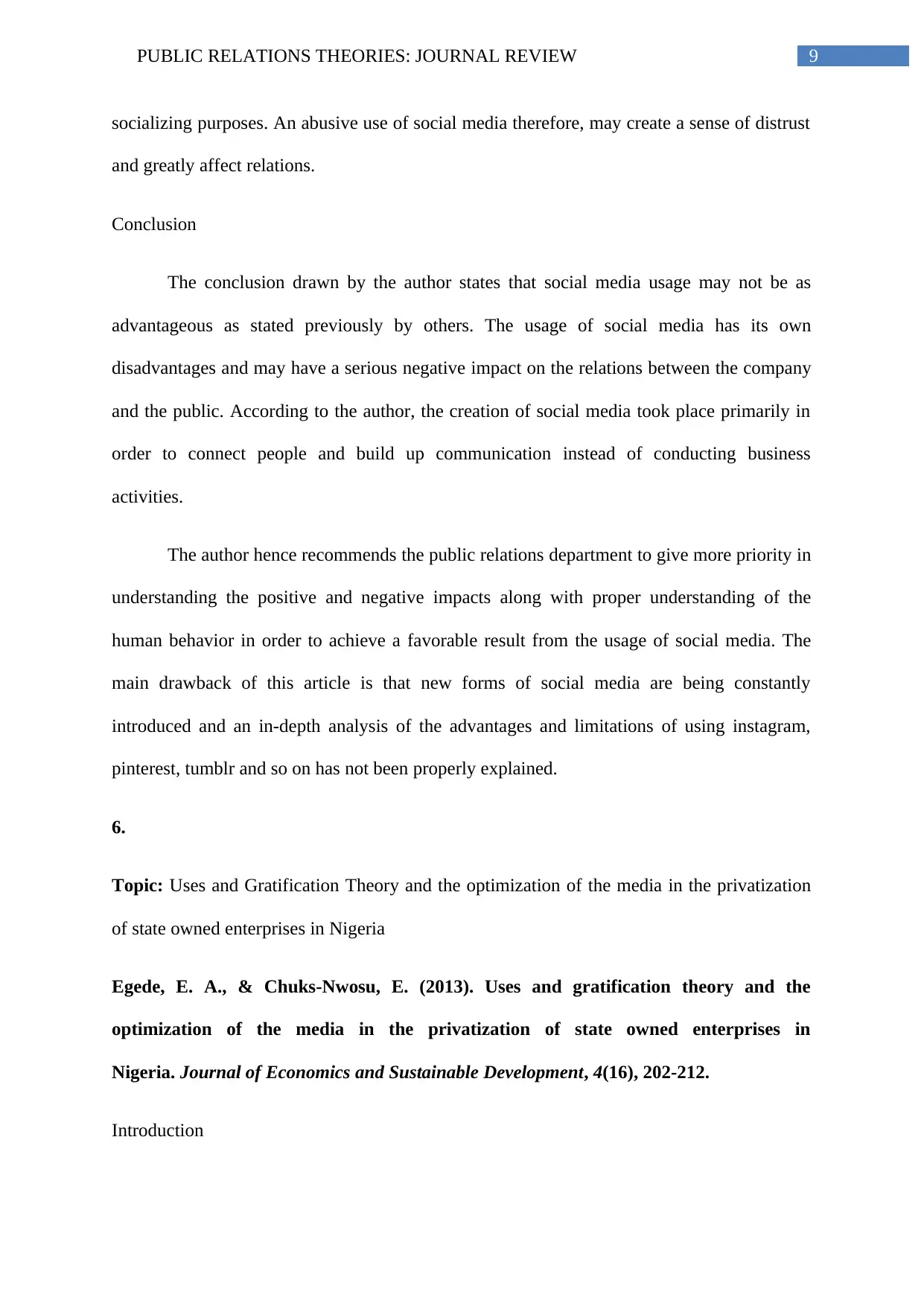
9PUBLIC RELATIONS THEORIES: JOURNAL REVIEW
socializing purposes. An abusive use of social media therefore, may create a sense of distrust
and greatly affect relations.
Conclusion
The conclusion drawn by the author states that social media usage may not be as
advantageous as stated previously by others. The usage of social media has its own
disadvantages and may have a serious negative impact on the relations between the company
and the public. According to the author, the creation of social media took place primarily in
order to connect people and build up communication instead of conducting business
activities.
The author hence recommends the public relations department to give more priority in
understanding the positive and negative impacts along with proper understanding of the
human behavior in order to achieve a favorable result from the usage of social media. The
main drawback of this article is that new forms of social media are being constantly
introduced and an in-depth analysis of the advantages and limitations of using instagram,
pinterest, tumblr and so on has not been properly explained.
6.
Topic: Uses and Gratification Theory and the optimization of the media in the privatization
of state owned enterprises in Nigeria
Egede, E. A., & Chuks-Nwosu, E. (2013). Uses and gratification theory and the
optimization of the media in the privatization of state owned enterprises in
Nigeria. Journal of Economics and Sustainable Development, 4(16), 202-212.
Introduction
socializing purposes. An abusive use of social media therefore, may create a sense of distrust
and greatly affect relations.
Conclusion
The conclusion drawn by the author states that social media usage may not be as
advantageous as stated previously by others. The usage of social media has its own
disadvantages and may have a serious negative impact on the relations between the company
and the public. According to the author, the creation of social media took place primarily in
order to connect people and build up communication instead of conducting business
activities.
The author hence recommends the public relations department to give more priority in
understanding the positive and negative impacts along with proper understanding of the
human behavior in order to achieve a favorable result from the usage of social media. The
main drawback of this article is that new forms of social media are being constantly
introduced and an in-depth analysis of the advantages and limitations of using instagram,
pinterest, tumblr and so on has not been properly explained.
6.
Topic: Uses and Gratification Theory and the optimization of the media in the privatization
of state owned enterprises in Nigeria
Egede, E. A., & Chuks-Nwosu, E. (2013). Uses and gratification theory and the
optimization of the media in the privatization of state owned enterprises in
Nigeria. Journal of Economics and Sustainable Development, 4(16), 202-212.
Introduction
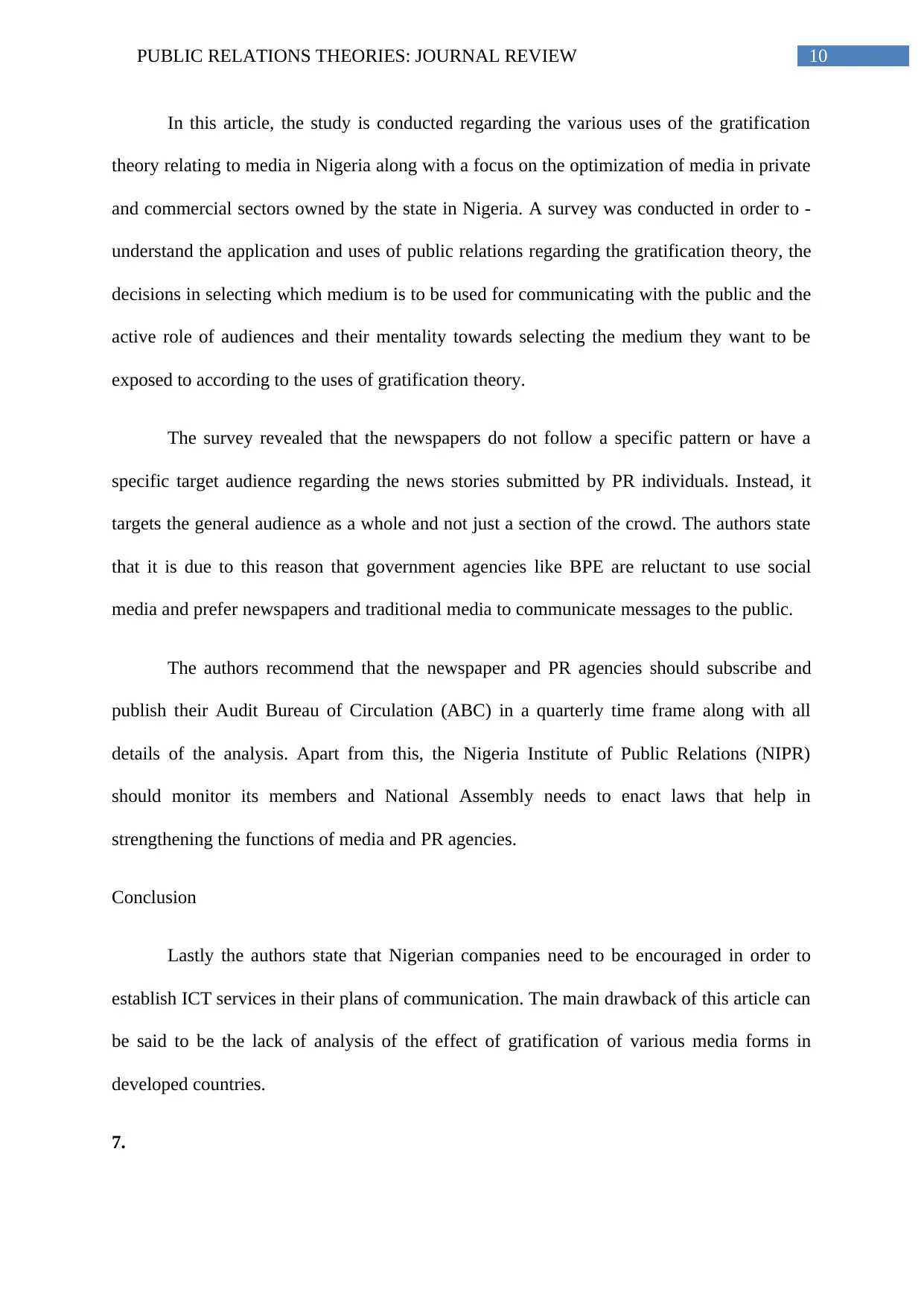
10PUBLIC RELATIONS THEORIES: JOURNAL REVIEW
In this article, the study is conducted regarding the various uses of the gratification
theory relating to media in Nigeria along with a focus on the optimization of media in private
and commercial sectors owned by the state in Nigeria. A survey was conducted in order to -
understand the application and uses of public relations regarding the gratification theory, the
decisions in selecting which medium is to be used for communicating with the public and the
active role of audiences and their mentality towards selecting the medium they want to be
exposed to according to the uses of gratification theory.
The survey revealed that the newspapers do not follow a specific pattern or have a
specific target audience regarding the news stories submitted by PR individuals. Instead, it
targets the general audience as a whole and not just a section of the crowd. The authors state
that it is due to this reason that government agencies like BPE are reluctant to use social
media and prefer newspapers and traditional media to communicate messages to the public.
The authors recommend that the newspaper and PR agencies should subscribe and
publish their Audit Bureau of Circulation (ABC) in a quarterly time frame along with all
details of the analysis. Apart from this, the Nigeria Institute of Public Relations (NIPR)
should monitor its members and National Assembly needs to enact laws that help in
strengthening the functions of media and PR agencies.
Conclusion
Lastly the authors state that Nigerian companies need to be encouraged in order to
establish ICT services in their plans of communication. The main drawback of this article can
be said to be the lack of analysis of the effect of gratification of various media forms in
developed countries.
7.
In this article, the study is conducted regarding the various uses of the gratification
theory relating to media in Nigeria along with a focus on the optimization of media in private
and commercial sectors owned by the state in Nigeria. A survey was conducted in order to -
understand the application and uses of public relations regarding the gratification theory, the
decisions in selecting which medium is to be used for communicating with the public and the
active role of audiences and their mentality towards selecting the medium they want to be
exposed to according to the uses of gratification theory.
The survey revealed that the newspapers do not follow a specific pattern or have a
specific target audience regarding the news stories submitted by PR individuals. Instead, it
targets the general audience as a whole and not just a section of the crowd. The authors state
that it is due to this reason that government agencies like BPE are reluctant to use social
media and prefer newspapers and traditional media to communicate messages to the public.
The authors recommend that the newspaper and PR agencies should subscribe and
publish their Audit Bureau of Circulation (ABC) in a quarterly time frame along with all
details of the analysis. Apart from this, the Nigeria Institute of Public Relations (NIPR)
should monitor its members and National Assembly needs to enact laws that help in
strengthening the functions of media and PR agencies.
Conclusion
Lastly the authors state that Nigerian companies need to be encouraged in order to
establish ICT services in their plans of communication. The main drawback of this article can
be said to be the lack of analysis of the effect of gratification of various media forms in
developed countries.
7.
Secure Best Marks with AI Grader
Need help grading? Try our AI Grader for instant feedback on your assignments.
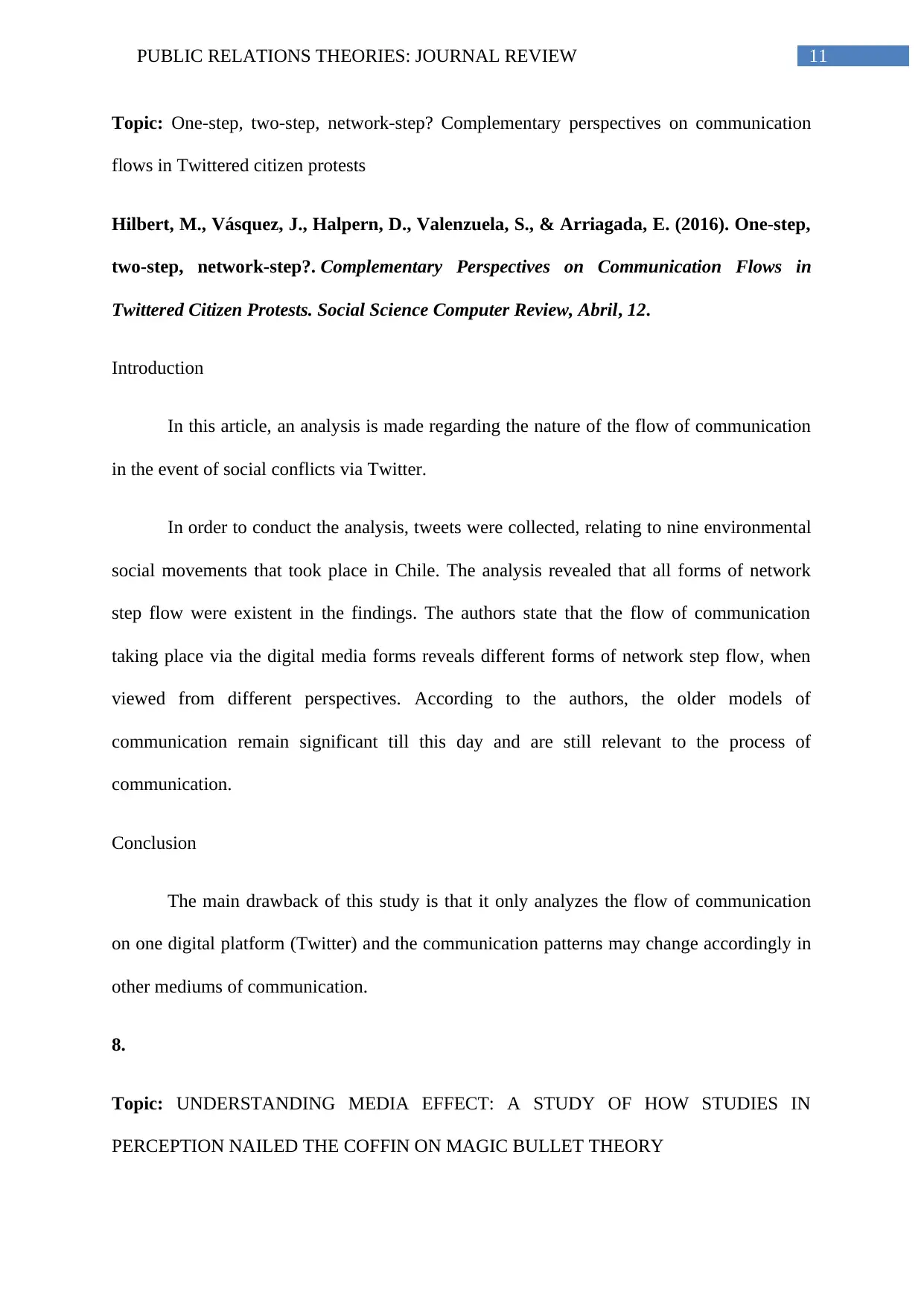
11PUBLIC RELATIONS THEORIES: JOURNAL REVIEW
Topic: One-step, two-step, network-step? Complementary perspectives on communication
flows in Twittered citizen protests
Hilbert, M., Vásquez, J., Halpern, D., Valenzuela, S., & Arriagada, E. (2016). One-step,
two-step, network-step?. Complementary Perspectives on Communication Flows in
Twittered Citizen Protests. Social Science Computer Review, Abril, 12.
Introduction
In this article, an analysis is made regarding the nature of the flow of communication
in the event of social conflicts via Twitter.
In order to conduct the analysis, tweets were collected, relating to nine environmental
social movements that took place in Chile. The analysis revealed that all forms of network
step flow were existent in the findings. The authors state that the flow of communication
taking place via the digital media forms reveals different forms of network step flow, when
viewed from different perspectives. According to the authors, the older models of
communication remain significant till this day and are still relevant to the process of
communication.
Conclusion
The main drawback of this study is that it only analyzes the flow of communication
on one digital platform (Twitter) and the communication patterns may change accordingly in
other mediums of communication.
8.
Topic: UNDERSTANDING MEDIA EFFECT: A STUDY OF HOW STUDIES IN
PERCEPTION NAILED THE COFFIN ON MAGIC BULLET THEORY
Topic: One-step, two-step, network-step? Complementary perspectives on communication
flows in Twittered citizen protests
Hilbert, M., Vásquez, J., Halpern, D., Valenzuela, S., & Arriagada, E. (2016). One-step,
two-step, network-step?. Complementary Perspectives on Communication Flows in
Twittered Citizen Protests. Social Science Computer Review, Abril, 12.
Introduction
In this article, an analysis is made regarding the nature of the flow of communication
in the event of social conflicts via Twitter.
In order to conduct the analysis, tweets were collected, relating to nine environmental
social movements that took place in Chile. The analysis revealed that all forms of network
step flow were existent in the findings. The authors state that the flow of communication
taking place via the digital media forms reveals different forms of network step flow, when
viewed from different perspectives. According to the authors, the older models of
communication remain significant till this day and are still relevant to the process of
communication.
Conclusion
The main drawback of this study is that it only analyzes the flow of communication
on one digital platform (Twitter) and the communication patterns may change accordingly in
other mediums of communication.
8.
Topic: UNDERSTANDING MEDIA EFFECT: A STUDY OF HOW STUDIES IN
PERCEPTION NAILED THE COFFIN ON MAGIC BULLET THEORY
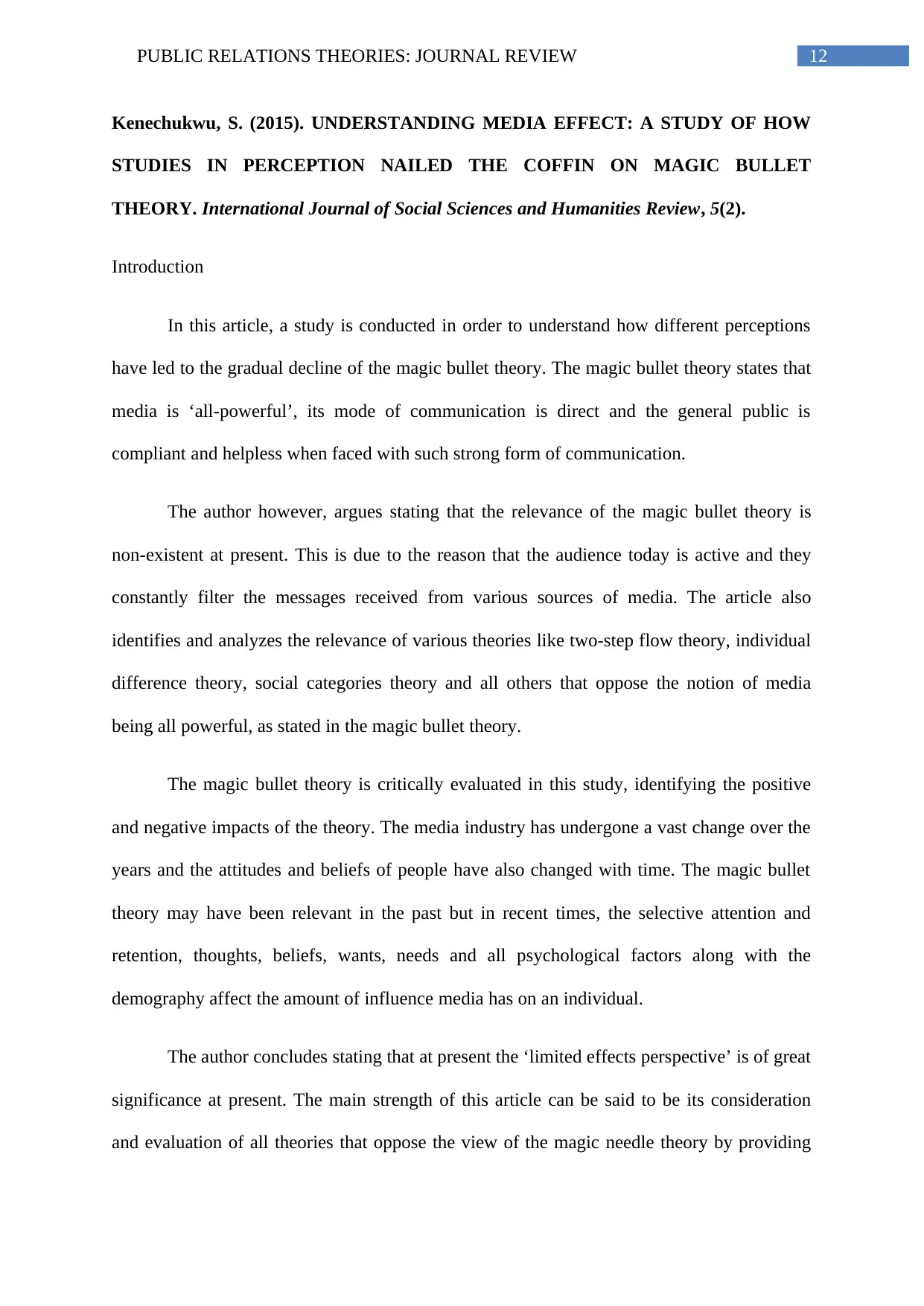
12PUBLIC RELATIONS THEORIES: JOURNAL REVIEW
Kenechukwu, S. (2015). UNDERSTANDING MEDIA EFFECT: A STUDY OF HOW
STUDIES IN PERCEPTION NAILED THE COFFIN ON MAGIC BULLET
THEORY. International Journal of Social Sciences and Humanities Review, 5(2).
Introduction
In this article, a study is conducted in order to understand how different perceptions
have led to the gradual decline of the magic bullet theory. The magic bullet theory states that
media is ‘all-powerful’, its mode of communication is direct and the general public is
compliant and helpless when faced with such strong form of communication.
The author however, argues stating that the relevance of the magic bullet theory is
non-existent at present. This is due to the reason that the audience today is active and they
constantly filter the messages received from various sources of media. The article also
identifies and analyzes the relevance of various theories like two-step flow theory, individual
difference theory, social categories theory and all others that oppose the notion of media
being all powerful, as stated in the magic bullet theory.
The magic bullet theory is critically evaluated in this study, identifying the positive
and negative impacts of the theory. The media industry has undergone a vast change over the
years and the attitudes and beliefs of people have also changed with time. The magic bullet
theory may have been relevant in the past but in recent times, the selective attention and
retention, thoughts, beliefs, wants, needs and all psychological factors along with the
demography affect the amount of influence media has on an individual.
The author concludes stating that at present the ‘limited effects perspective’ is of great
significance at present. The main strength of this article can be said to be its consideration
and evaluation of all theories that oppose the view of the magic needle theory by providing
Kenechukwu, S. (2015). UNDERSTANDING MEDIA EFFECT: A STUDY OF HOW
STUDIES IN PERCEPTION NAILED THE COFFIN ON MAGIC BULLET
THEORY. International Journal of Social Sciences and Humanities Review, 5(2).
Introduction
In this article, a study is conducted in order to understand how different perceptions
have led to the gradual decline of the magic bullet theory. The magic bullet theory states that
media is ‘all-powerful’, its mode of communication is direct and the general public is
compliant and helpless when faced with such strong form of communication.
The author however, argues stating that the relevance of the magic bullet theory is
non-existent at present. This is due to the reason that the audience today is active and they
constantly filter the messages received from various sources of media. The article also
identifies and analyzes the relevance of various theories like two-step flow theory, individual
difference theory, social categories theory and all others that oppose the notion of media
being all powerful, as stated in the magic bullet theory.
The magic bullet theory is critically evaluated in this study, identifying the positive
and negative impacts of the theory. The media industry has undergone a vast change over the
years and the attitudes and beliefs of people have also changed with time. The magic bullet
theory may have been relevant in the past but in recent times, the selective attention and
retention, thoughts, beliefs, wants, needs and all psychological factors along with the
demography affect the amount of influence media has on an individual.
The author concludes stating that at present the ‘limited effects perspective’ is of great
significance at present. The main strength of this article can be said to be its consideration
and evaluation of all theories that oppose the view of the magic needle theory by providing
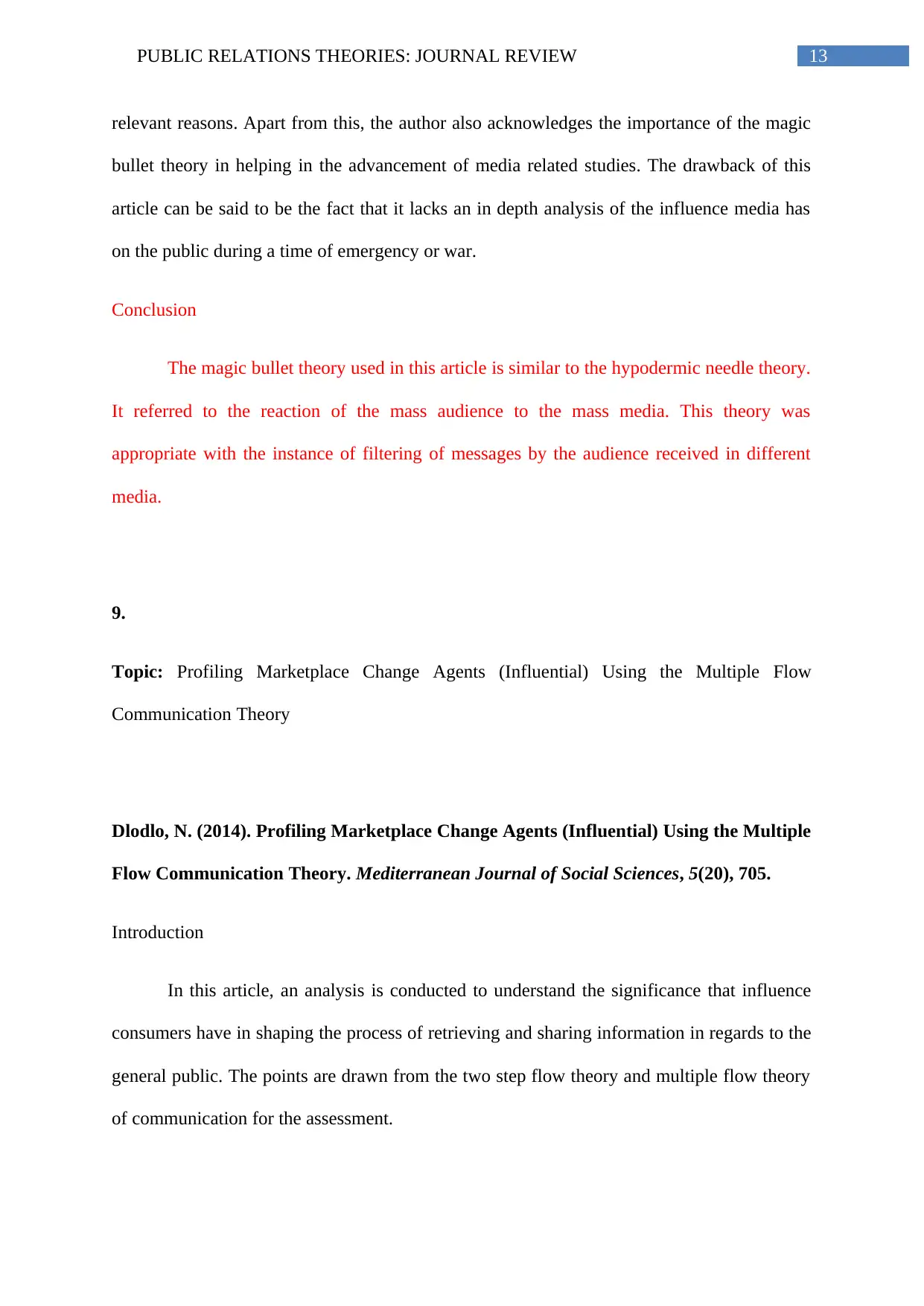
13PUBLIC RELATIONS THEORIES: JOURNAL REVIEW
relevant reasons. Apart from this, the author also acknowledges the importance of the magic
bullet theory in helping in the advancement of media related studies. The drawback of this
article can be said to be the fact that it lacks an in depth analysis of the influence media has
on the public during a time of emergency or war.
Conclusion
The magic bullet theory used in this article is similar to the hypodermic needle theory.
It referred to the reaction of the mass audience to the mass media. This theory was
appropriate with the instance of filtering of messages by the audience received in different
media.
9.
Topic: Profiling Marketplace Change Agents (Influential) Using the Multiple Flow
Communication Theory
Dlodlo, N. (2014). Profiling Marketplace Change Agents (Influential) Using the Multiple
Flow Communication Theory. Mediterranean Journal of Social Sciences, 5(20), 705.
Introduction
In this article, an analysis is conducted to understand the significance that influence
consumers have in shaping the process of retrieving and sharing information in regards to the
general public. The points are drawn from the two step flow theory and multiple flow theory
of communication for the assessment.
relevant reasons. Apart from this, the author also acknowledges the importance of the magic
bullet theory in helping in the advancement of media related studies. The drawback of this
article can be said to be the fact that it lacks an in depth analysis of the influence media has
on the public during a time of emergency or war.
Conclusion
The magic bullet theory used in this article is similar to the hypodermic needle theory.
It referred to the reaction of the mass audience to the mass media. This theory was
appropriate with the instance of filtering of messages by the audience received in different
media.
9.
Topic: Profiling Marketplace Change Agents (Influential) Using the Multiple Flow
Communication Theory
Dlodlo, N. (2014). Profiling Marketplace Change Agents (Influential) Using the Multiple
Flow Communication Theory. Mediterranean Journal of Social Sciences, 5(20), 705.
Introduction
In this article, an analysis is conducted to understand the significance that influence
consumers have in shaping the process of retrieving and sharing information in regards to the
general public. The points are drawn from the two step flow theory and multiple flow theory
of communication for the assessment.
Paraphrase This Document
Need a fresh take? Get an instant paraphrase of this document with our AI Paraphraser
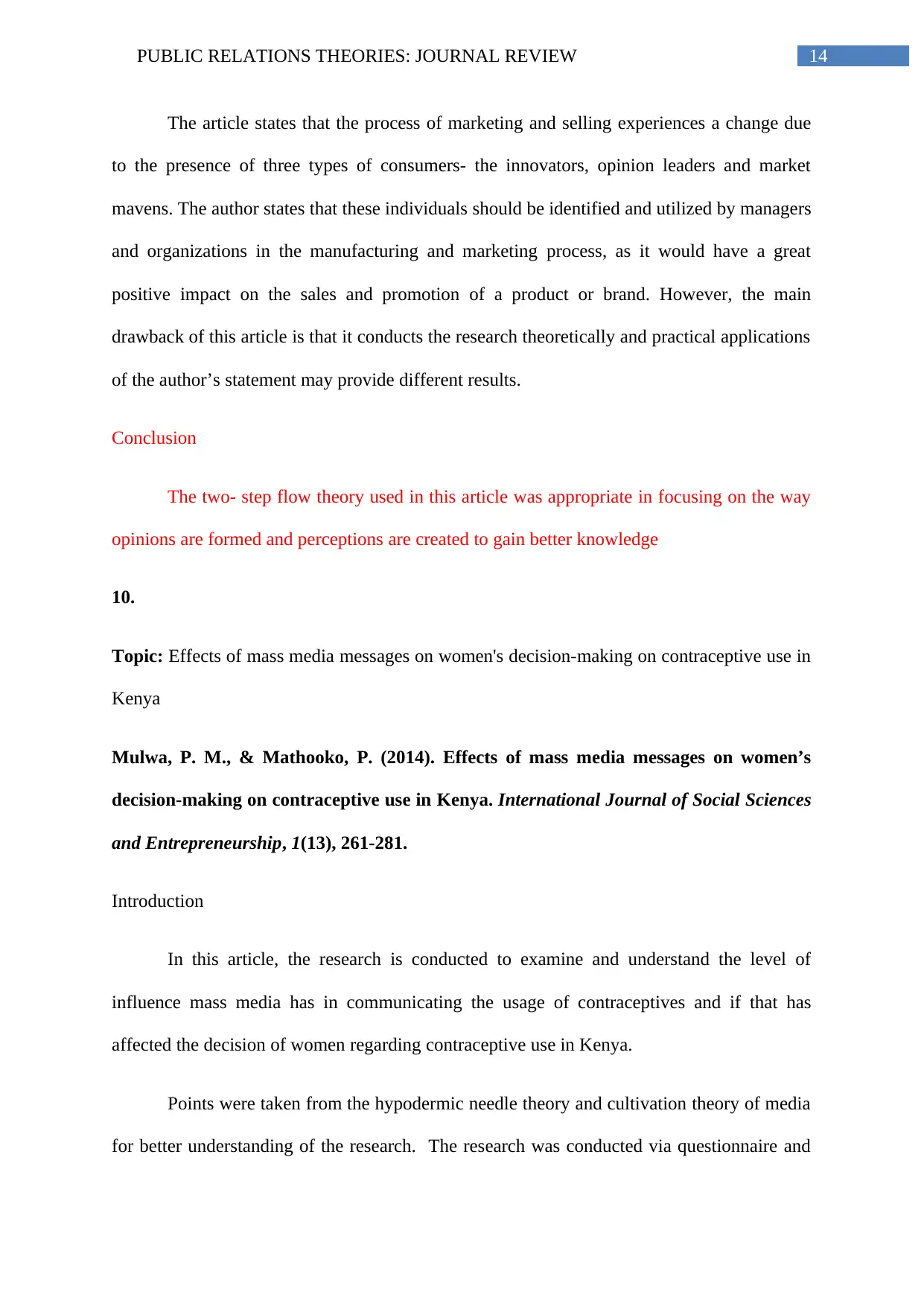
14PUBLIC RELATIONS THEORIES: JOURNAL REVIEW
The article states that the process of marketing and selling experiences a change due
to the presence of three types of consumers- the innovators, opinion leaders and market
mavens. The author states that these individuals should be identified and utilized by managers
and organizations in the manufacturing and marketing process, as it would have a great
positive impact on the sales and promotion of a product or brand. However, the main
drawback of this article is that it conducts the research theoretically and practical applications
of the author’s statement may provide different results.
Conclusion
The two- step flow theory used in this article was appropriate in focusing on the way
opinions are formed and perceptions are created to gain better knowledge
10.
Topic: Effects of mass media messages on women's decision-making on contraceptive use in
Kenya
Mulwa, P. M., & Mathooko, P. (2014). Effects of mass media messages on women’s
decision-making on contraceptive use in Kenya. International Journal of Social Sciences
and Entrepreneurship, 1(13), 261-281.
Introduction
In this article, the research is conducted to examine and understand the level of
influence mass media has in communicating the usage of contraceptives and if that has
affected the decision of women regarding contraceptive use in Kenya.
Points were taken from the hypodermic needle theory and cultivation theory of media
for better understanding of the research. The research was conducted via questionnaire and
The article states that the process of marketing and selling experiences a change due
to the presence of three types of consumers- the innovators, opinion leaders and market
mavens. The author states that these individuals should be identified and utilized by managers
and organizations in the manufacturing and marketing process, as it would have a great
positive impact on the sales and promotion of a product or brand. However, the main
drawback of this article is that it conducts the research theoretically and practical applications
of the author’s statement may provide different results.
Conclusion
The two- step flow theory used in this article was appropriate in focusing on the way
opinions are formed and perceptions are created to gain better knowledge
10.
Topic: Effects of mass media messages on women's decision-making on contraceptive use in
Kenya
Mulwa, P. M., & Mathooko, P. (2014). Effects of mass media messages on women’s
decision-making on contraceptive use in Kenya. International Journal of Social Sciences
and Entrepreneurship, 1(13), 261-281.
Introduction
In this article, the research is conducted to examine and understand the level of
influence mass media has in communicating the usage of contraceptives and if that has
affected the decision of women regarding contraceptive use in Kenya.
Points were taken from the hypodermic needle theory and cultivation theory of media
for better understanding of the research. The research was conducted via questionnaire and
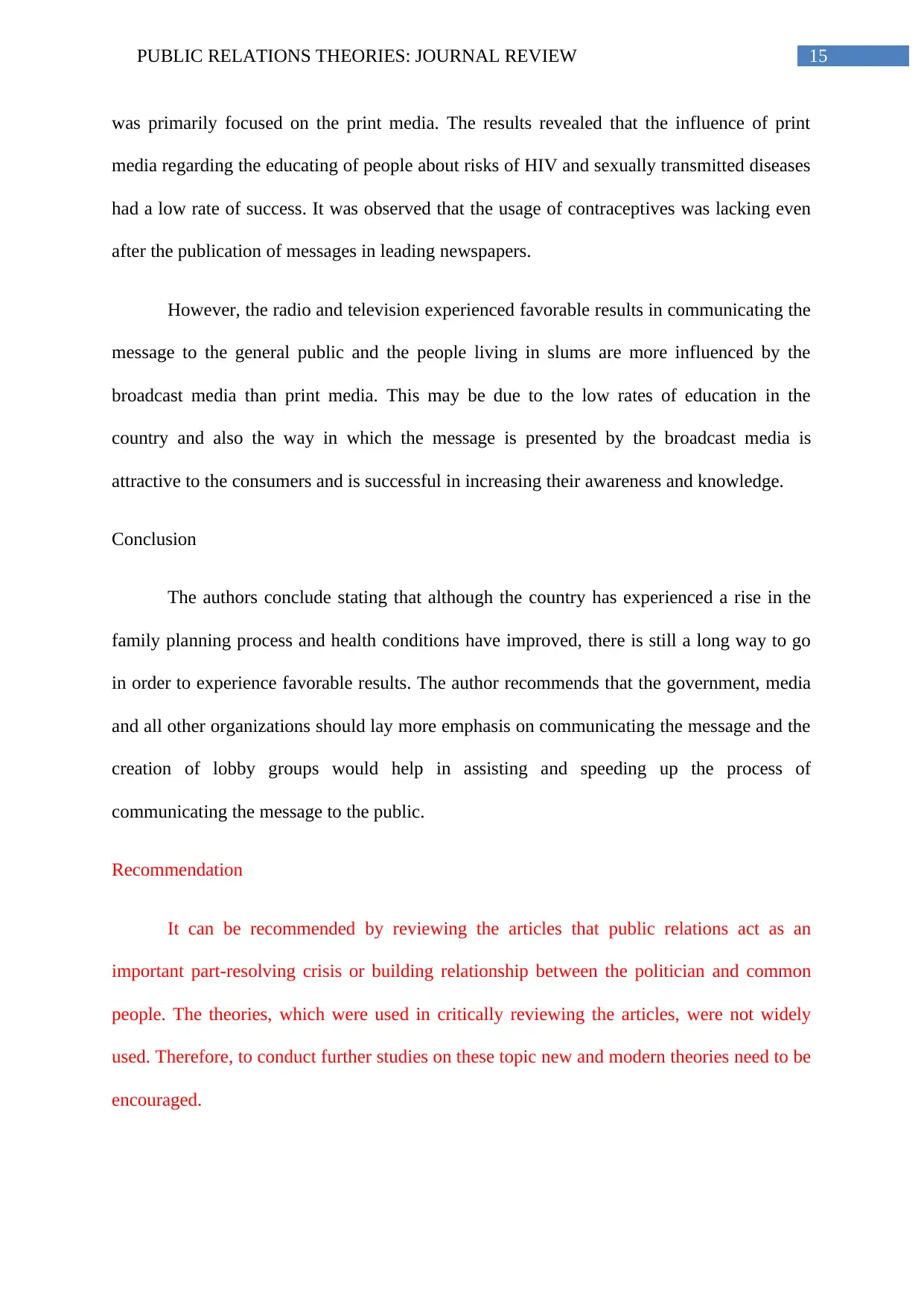
15PUBLIC RELATIONS THEORIES: JOURNAL REVIEW
was primarily focused on the print media. The results revealed that the influence of print
media regarding the educating of people about risks of HIV and sexually transmitted diseases
had a low rate of success. It was observed that the usage of contraceptives was lacking even
after the publication of messages in leading newspapers.
However, the radio and television experienced favorable results in communicating the
message to the general public and the people living in slums are more influenced by the
broadcast media than print media. This may be due to the low rates of education in the
country and also the way in which the message is presented by the broadcast media is
attractive to the consumers and is successful in increasing their awareness and knowledge.
Conclusion
The authors conclude stating that although the country has experienced a rise in the
family planning process and health conditions have improved, there is still a long way to go
in order to experience favorable results. The author recommends that the government, media
and all other organizations should lay more emphasis on communicating the message and the
creation of lobby groups would help in assisting and speeding up the process of
communicating the message to the public.
Recommendation
It can be recommended by reviewing the articles that public relations act as an
important part-resolving crisis or building relationship between the politician and common
people. The theories, which were used in critically reviewing the articles, were not widely
used. Therefore, to conduct further studies on these topic new and modern theories need to be
encouraged.
was primarily focused on the print media. The results revealed that the influence of print
media regarding the educating of people about risks of HIV and sexually transmitted diseases
had a low rate of success. It was observed that the usage of contraceptives was lacking even
after the publication of messages in leading newspapers.
However, the radio and television experienced favorable results in communicating the
message to the general public and the people living in slums are more influenced by the
broadcast media than print media. This may be due to the low rates of education in the
country and also the way in which the message is presented by the broadcast media is
attractive to the consumers and is successful in increasing their awareness and knowledge.
Conclusion
The authors conclude stating that although the country has experienced a rise in the
family planning process and health conditions have improved, there is still a long way to go
in order to experience favorable results. The author recommends that the government, media
and all other organizations should lay more emphasis on communicating the message and the
creation of lobby groups would help in assisting and speeding up the process of
communicating the message to the public.
Recommendation
It can be recommended by reviewing the articles that public relations act as an
important part-resolving crisis or building relationship between the politician and common
people. The theories, which were used in critically reviewing the articles, were not widely
used. Therefore, to conduct further studies on these topic new and modern theories need to be
encouraged.
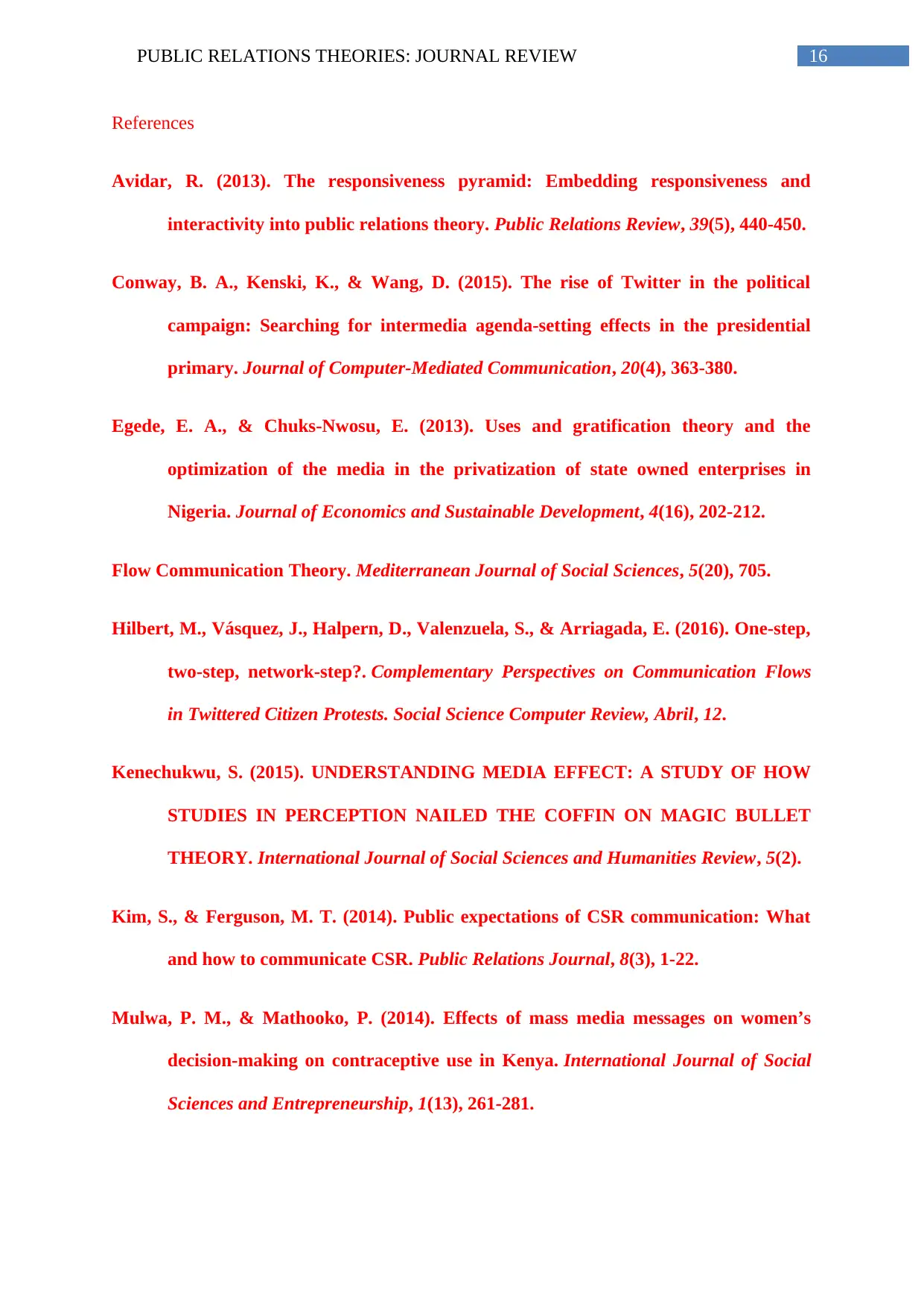
16PUBLIC RELATIONS THEORIES: JOURNAL REVIEW
References
Avidar, R. (2013). The responsiveness pyramid: Embedding responsiveness and
interactivity into public relations theory. Public Relations Review, 39(5), 440-450.
Conway, B. A., Kenski, K., & Wang, D. (2015). The rise of Twitter in the political
campaign: Searching for intermedia agenda-setting effects in the presidential
primary. Journal of Computer-Mediated Communication, 20(4), 363-380.
Egede, E. A., & Chuks-Nwosu, E. (2013). Uses and gratification theory and the
optimization of the media in the privatization of state owned enterprises in
Nigeria. Journal of Economics and Sustainable Development, 4(16), 202-212.
Flow Communication Theory. Mediterranean Journal of Social Sciences, 5(20), 705.
Hilbert, M., Vásquez, J., Halpern, D., Valenzuela, S., & Arriagada, E. (2016). One-step,
two-step, network-step?. Complementary Perspectives on Communication Flows
in Twittered Citizen Protests. Social Science Computer Review, Abril, 12.
Kenechukwu, S. (2015). UNDERSTANDING MEDIA EFFECT: A STUDY OF HOW
STUDIES IN PERCEPTION NAILED THE COFFIN ON MAGIC BULLET
THEORY. International Journal of Social Sciences and Humanities Review, 5(2).
Kim, S., & Ferguson, M. T. (2014). Public expectations of CSR communication: What
and how to communicate CSR. Public Relations Journal, 8(3), 1-22.
Mulwa, P. M., & Mathooko, P. (2014). Effects of mass media messages on women’s
decision-making on contraceptive use in Kenya. International Journal of Social
Sciences and Entrepreneurship, 1(13), 261-281.
References
Avidar, R. (2013). The responsiveness pyramid: Embedding responsiveness and
interactivity into public relations theory. Public Relations Review, 39(5), 440-450.
Conway, B. A., Kenski, K., & Wang, D. (2015). The rise of Twitter in the political
campaign: Searching for intermedia agenda-setting effects in the presidential
primary. Journal of Computer-Mediated Communication, 20(4), 363-380.
Egede, E. A., & Chuks-Nwosu, E. (2013). Uses and gratification theory and the
optimization of the media in the privatization of state owned enterprises in
Nigeria. Journal of Economics and Sustainable Development, 4(16), 202-212.
Flow Communication Theory. Mediterranean Journal of Social Sciences, 5(20), 705.
Hilbert, M., Vásquez, J., Halpern, D., Valenzuela, S., & Arriagada, E. (2016). One-step,
two-step, network-step?. Complementary Perspectives on Communication Flows
in Twittered Citizen Protests. Social Science Computer Review, Abril, 12.
Kenechukwu, S. (2015). UNDERSTANDING MEDIA EFFECT: A STUDY OF HOW
STUDIES IN PERCEPTION NAILED THE COFFIN ON MAGIC BULLET
THEORY. International Journal of Social Sciences and Humanities Review, 5(2).
Kim, S., & Ferguson, M. T. (2014). Public expectations of CSR communication: What
and how to communicate CSR. Public Relations Journal, 8(3), 1-22.
Mulwa, P. M., & Mathooko, P. (2014). Effects of mass media messages on women’s
decision-making on contraceptive use in Kenya. International Journal of Social
Sciences and Entrepreneurship, 1(13), 261-281.
Secure Best Marks with AI Grader
Need help grading? Try our AI Grader for instant feedback on your assignments.
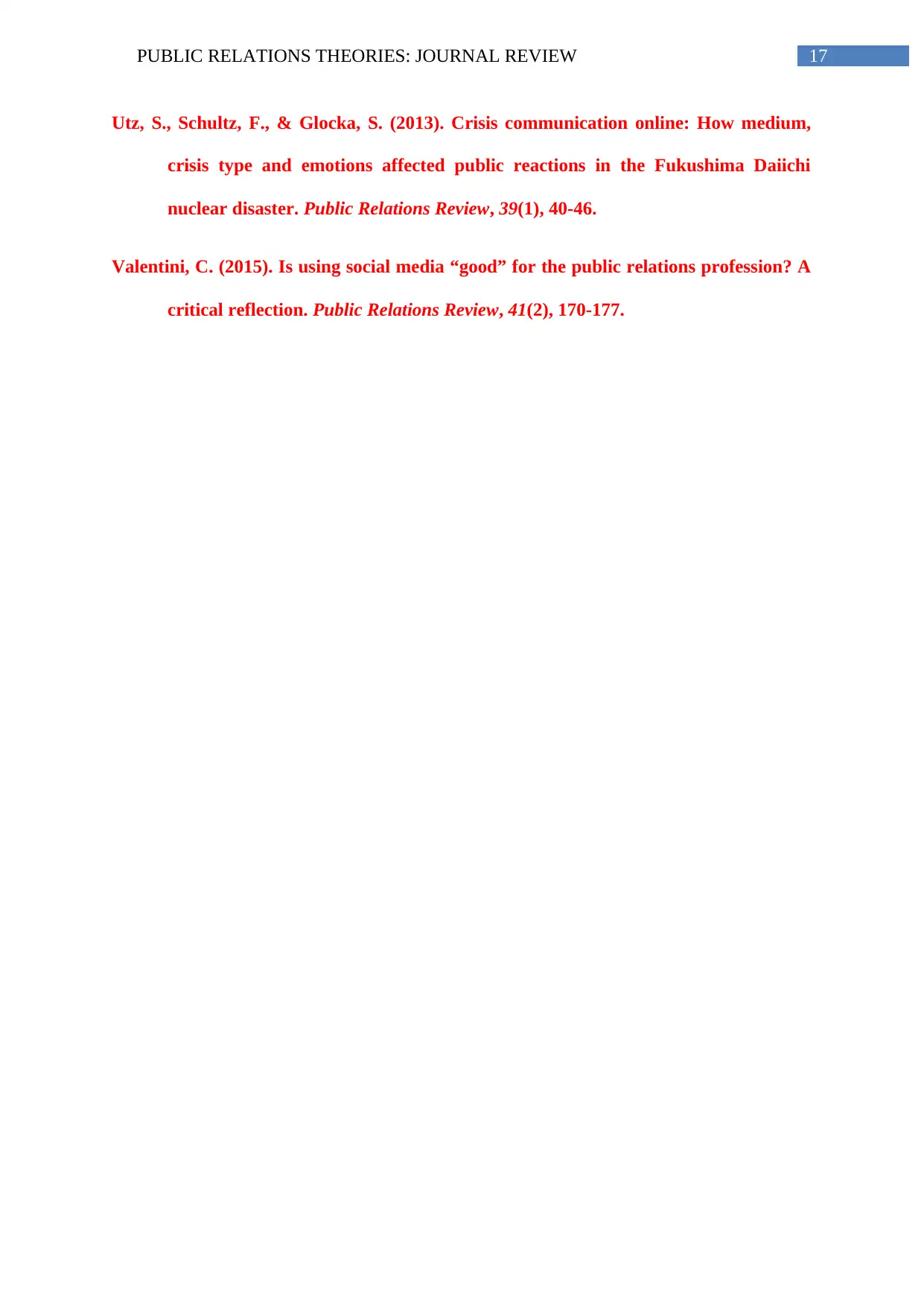
17PUBLIC RELATIONS THEORIES: JOURNAL REVIEW
Utz, S., Schultz, F., & Glocka, S. (2013). Crisis communication online: How medium,
crisis type and emotions affected public reactions in the Fukushima Daiichi
nuclear disaster. Public Relations Review, 39(1), 40-46.
Valentini, C. (2015). Is using social media “good” for the public relations profession? A
critical reflection. Public Relations Review, 41(2), 170-177.
Utz, S., Schultz, F., & Glocka, S. (2013). Crisis communication online: How medium,
crisis type and emotions affected public reactions in the Fukushima Daiichi
nuclear disaster. Public Relations Review, 39(1), 40-46.
Valentini, C. (2015). Is using social media “good” for the public relations profession? A
critical reflection. Public Relations Review, 41(2), 170-177.
1 out of 17
Related Documents
Your All-in-One AI-Powered Toolkit for Academic Success.
+13062052269
info@desklib.com
Available 24*7 on WhatsApp / Email
![[object Object]](/_next/static/media/star-bottom.7253800d.svg)
Unlock your academic potential
© 2024 | Zucol Services PVT LTD | All rights reserved.





